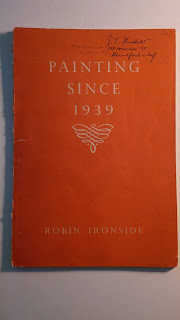While we hear a lot about Bacon, Bell, Moore, Nash and Sutherland (below, 1940), there is little discussion of paintings made by women. Only Frances Mary Hodgkins and Ethel Walker bear mention: the former described as a member of the Seven and Five Society in her bio; the latter described as a painter of "portraits, flower-pieces, sea-pieces and decorative compositions" in hers.
The best part of this book, or why Rolf gave it to me, concerns its previous owner, whose name and address are written on its cover. Crossed out next to "886 Thurlow St, Vancouver B.C." is "J. L. Shadbolt 128 Monroe St. New York, NY."
Here is a text supplied by Heffel Fine Art Auction House that describes Shadbolt's year in NYC:
"From September 1948 to August 1949, Jack Shadbolt was in New York City, during a time of great vitality in the visual arts that saw the emergence of the New York School of painters. While there, he was drawn to the work of painters such as Arshile Gorky and Pablo Picasso, whose monumental anti-war painting Guernica electrified the art world. Emerging from the shadow of World War II and its anxieties, Shadbolt felt that only abstraction could express the spirit of the times and began to produce vital works such as this one. This powerful watercolour is a study for Shadbolt’s 1948 oil The Great Ones [below], sold for a record price in Heffel’s spring 2009 auction. Both are early abstract works that still retain ties to figuration—for as Scott Watson maintained, “Works like The Great Ones depict fierce abstract totem figures.” Shadbolt was still abstracting from something, whether figures or from nature, and his abstract works were symbolic. Works such as this marked a turning point in Shadbolt’s career and helped to establish his prominence as one of Canada’s leading modernist painters."




No comments:
Post a Comment